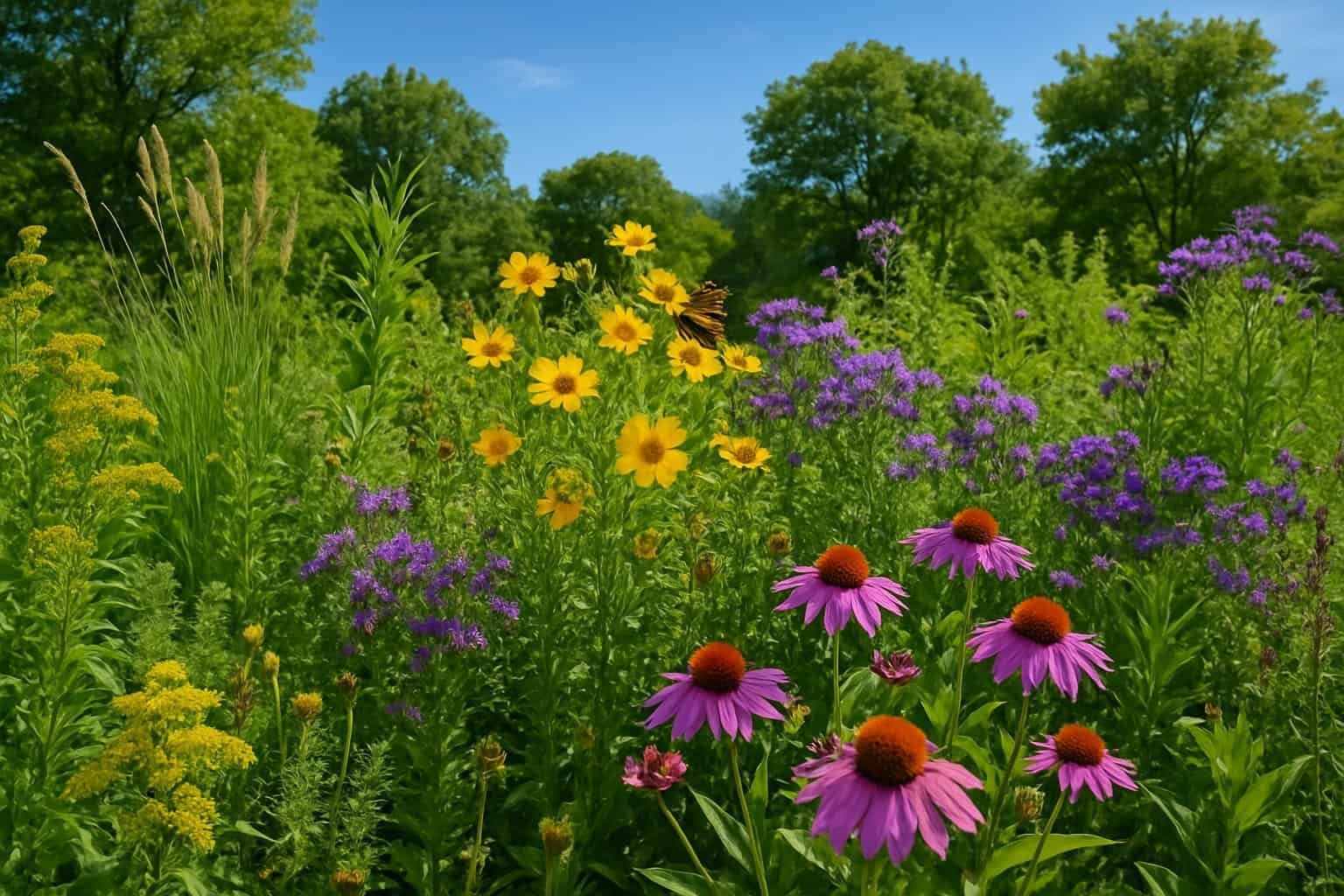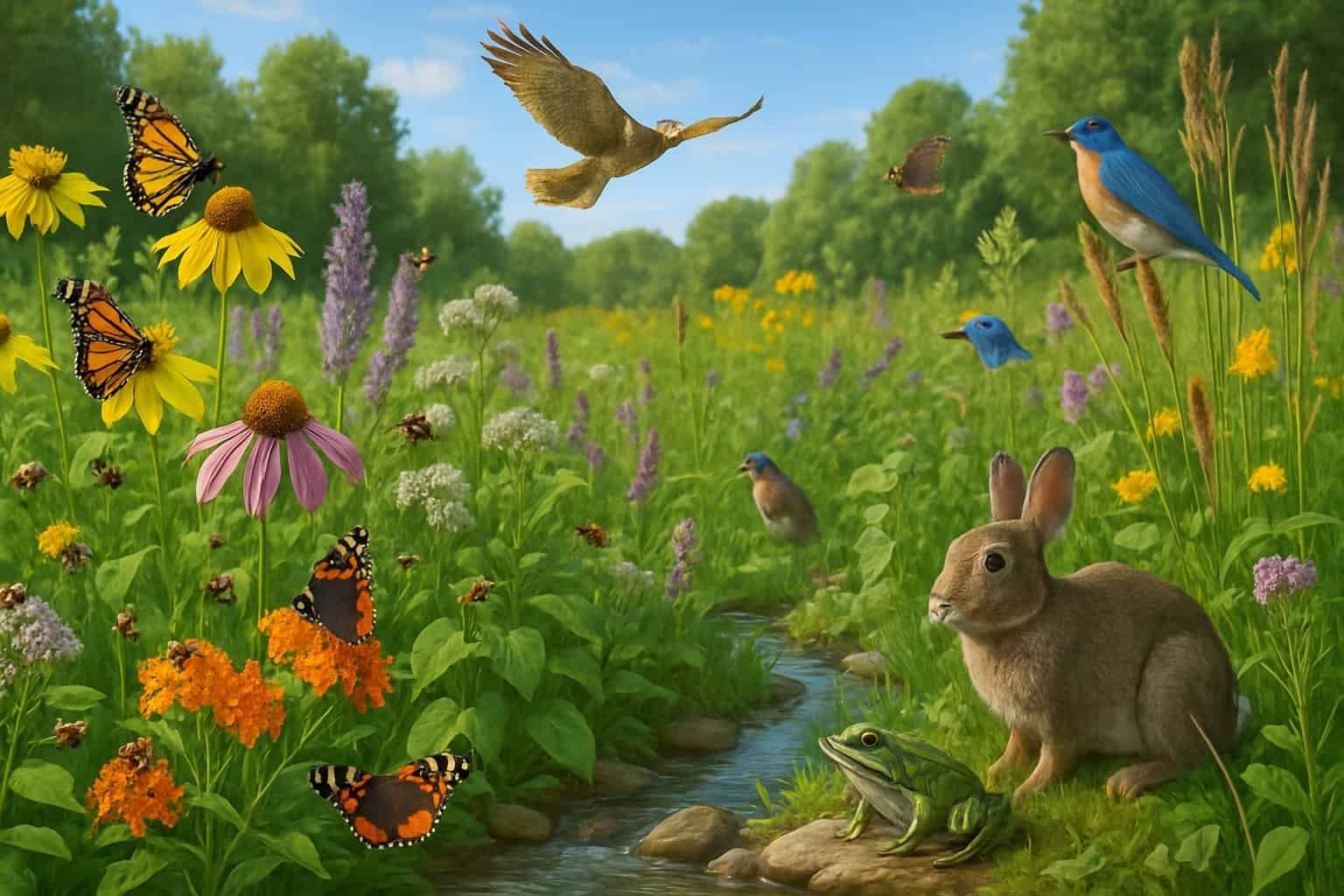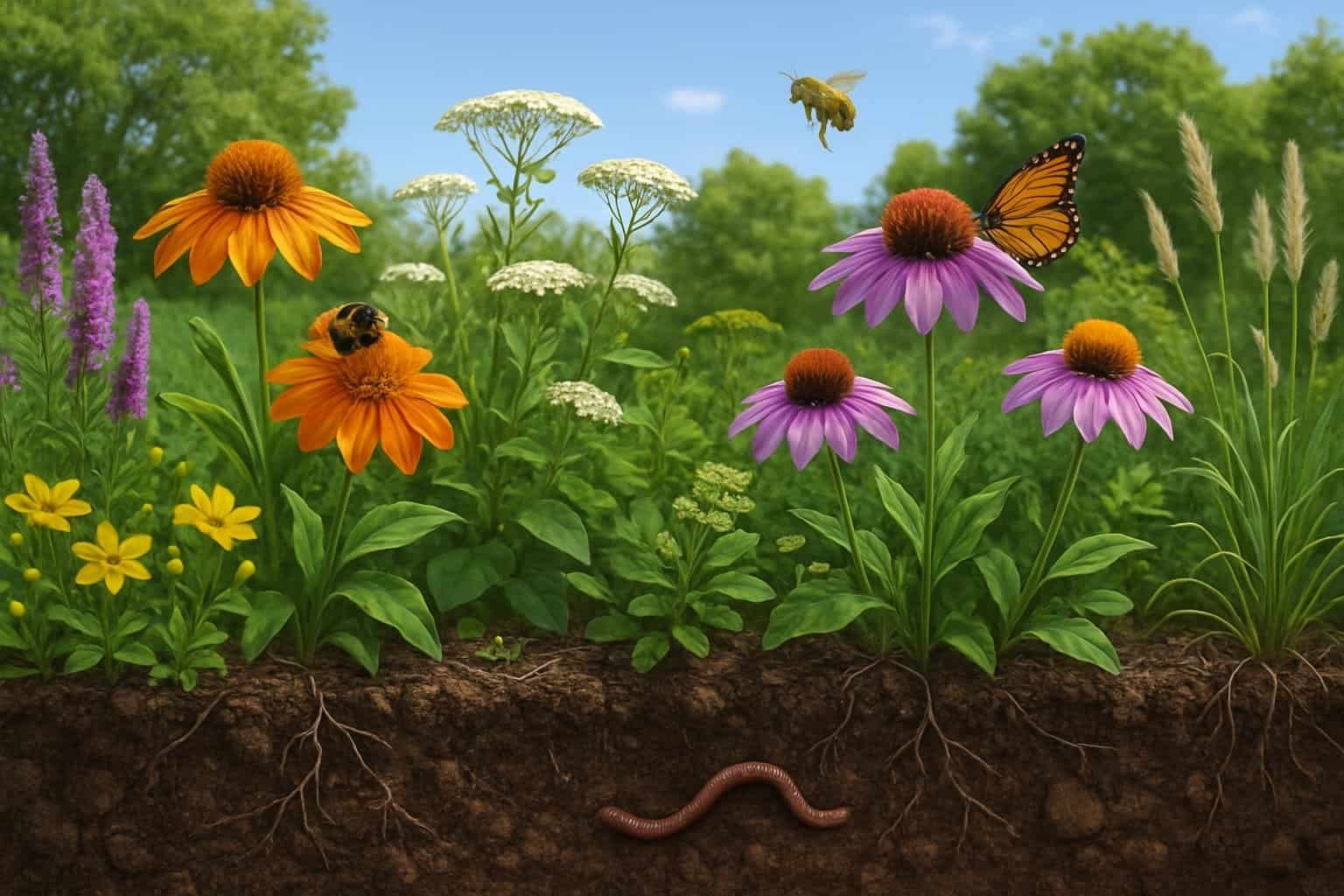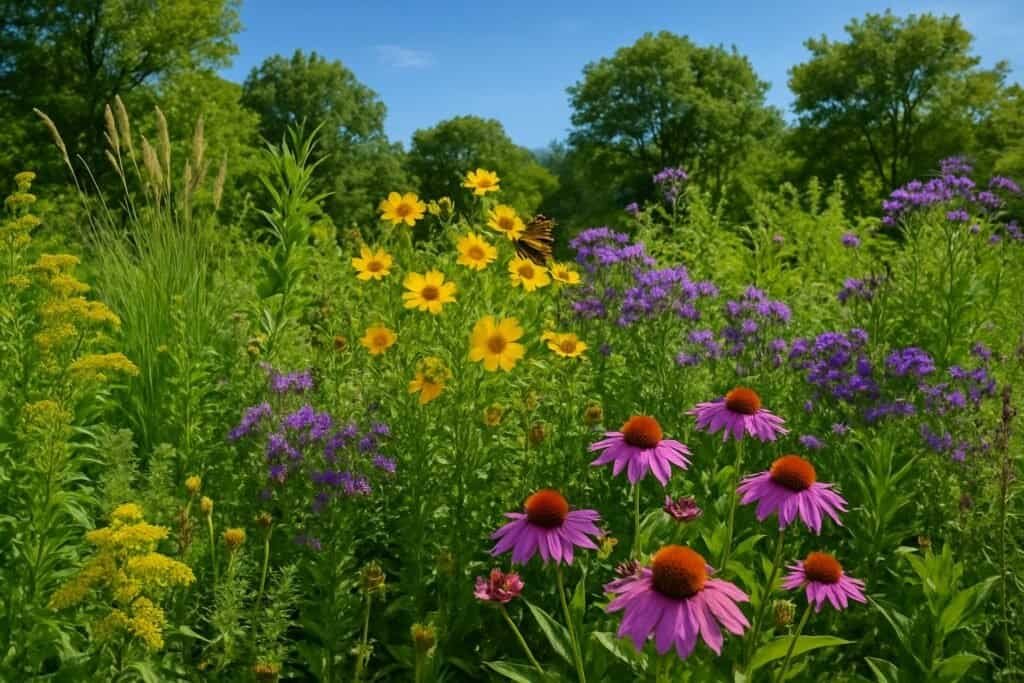Native plants offer many benefits for your garden and the environment. These plants have grown in your region for thousands of years, adapting perfectly to local soil and weather conditions.
Native plants support local ecosystems by providing food and shelter for birds, butterflies, and other wildlife. They require less water, fertilizer, and maintenance than non-native species.

When you choose native plants, you help preserve biodiversity in your area. They create natural habitats that might otherwise disappear due to development and the spread of invasive species.
Native plants also have deep root systems that help prevent erosion. These roots filter water as it returns to the ground.
Key Takeaways
- Native plants require less maintenance, water, and chemicals while thriving in local conditions.
- Local wildlife depends on native plant species for food and habitat, supporting the entire ecosystem.
- Adding native plants to your landscape helps preserve biodiversity and creates a unique sense of regional identity.
Supporting Local Ecosystems
Native plants play a vital role in creating healthy environments for wildlife. They form the foundation of local food webs and help preserve the unique character of our landscapes.
Enhancing Biodiversity
Native plants support more wildlife than non-native alternatives. Research shows that native oak trees can host over 500 species of caterpillars, while non-native trees like ginkgo support fewer than 5 species.
Caterpillars are essential food for baby birds. Native plants provide the right nectar, pollen, and seeds that local wildlife evolved to depend on.
Birds, butterflies, and bees recognize these plants as food sources. Many pollinators can only reproduce on specific native plants.
For example, monarch butterflies lay eggs exclusively on milkweed plants. Without native milkweed, monarch populations decline dramatically.
Maintaining Functioning Ecosystems
Native plants strengthen ecosystem resilience through their deep root systems. These roots prevent soil erosion and filter water, improving water quality in local streams and lakes.
Many native plants can survive local weather extremes without extra water or care. Prairie grasses, for instance, can develop roots up to 15 feet deep.
Native plant communities work together to:
- Create wildlife habitat
- Store carbon in soil
- Regulate local temperature
- Control stormwater runoff
These benefits occur naturally when the right plants grow in the right places. Native plant communities maintain these functions with minimal human intervention.
Preserving Natural Areas
Natural areas with native plants represent the ecological heritage of a region. These areas showcase plants that have grown there for centuries, reflecting local conditions and history.
Native plant preservation protects rare and endangered species. Many unique plants only grow in specific regions and face extinction without protection.
California’s Channel Islands, for example, contain 145 plant species found nowhere else on Earth. Protecting natural areas creates wildlife corridors that connect habitats.
Animals can move safely between these areas to find food, mates, and shelter. Even small patches of native plants in urban areas serve as stepping stones for migrating birds and insects.
The desert plants of Arizona, coastal vegetation of Maine, and prairie grasses of Kansas each create a unique sense of place.
Wildlife Habitat and Food Webs

Native plants form the foundation of healthy ecosystems by creating complex food webs. They provide critical resources for local wildlife.
These plants have evolved alongside native animals for thousands of years. They create relationships that non-native plants cannot replace.
Providing Food for Birds and Mammals
Native plants produce berries, nuts, and seeds that perfectly match the nutritional needs of local birds and mammals. Oak trees, for example, can support over 500 species of caterpillars, which become food for birds.
A single chickadee pair needs 6,000-9,000 caterpillars to raise one brood of young. Many native shrubs like elderberry and serviceberry produce fruits at different times throughout the year.
This creates a reliable food calendar for wildlife. Squirrels, chipmunks, and mice depend on native nuts and seeds for winter survival.
Unlike many ornamental plants, native species provide fats and proteins in the right amounts and at the right times. Native grasses offer both seeds and shelter for small mammals and ground-feeding birds.
Supporting Insects, Butterflies, and Caterpillars
Native insects have specialized relationships with native plants. Monarch butterflies, for instance, can only lay eggs on milkweed plants.
Their caterpillars cannot survive on any other plant. Over 90% of plant-eating insects are specialists that can only eat plants they evolved with.
These insects form the base of the food web. Native flowers provide essential nectar for pollinators.
Different flower shapes suit different pollinators—tubular flowers for hummingbirds, landing-pad shapes for butterflies, and tiny clustered flowers for small bees. Bats rely on night-blooming native plants for food.
A single bat can eat thousands of insects each night, many of which are agricultural pests.
Shelter and Nesting Resources
Native trees and shrubs offer ideal nesting sites with the right branch structures and leaf densities. Birds like cardinals prefer dense native shrubs that protect nests from predators and weather.
Hollow trees and snags (dead standing trees) provide homes for woodpeckers, owls, and small mammals. These features are often missing in manicured landscapes with non-native plants.
Native grasses and perennials create ground-level habitat for beneficial insects through winter. Many butterfly and moth species overwinter in leaf litter or inside hollow plant stems.
A mix of native ground covers, shrubs, and trees creates a complete habitat structure.
Environmental Benefits

Native plants provide significant ecological advantages that benefit our surroundings in multiple ways. These plants have evolved over thousands of years to thrive in local conditions without extensive human intervention.
Soil Health and Erosion Control
Native plants develop extensive root systems that hold soil in place effectively. These deep roots can extend several feet underground, creating networks that prevent erosion during heavy rainfall or flooding events.
Native plant roots also improve soil structure by creating channels for water and air to move through the soil. This enhanced structure leads to better water infiltration and reduced runoff.
Soil organisms thrive around native plant roots. Beneficial bacteria, fungi, and other microorganisms form symbiotic relationships with native plants, enhancing nutrient cycling and overall soil health.
When planted on slopes or near waterways, native plants serve as living erosion barriers. Their ability to stabilize soil makes them excellent choices for restoration projects in damaged landscapes.
Water Conservation and Drought Resistance
Native plants typically require significantly less water than non-native species once established. They’ve adapted to local rainfall patterns and can survive with minimal supplemental irrigation.
During drought periods, many native species enter dormancy rather than dying. This natural adaptation allows them to withstand extended dry spells and recover quickly when conditions improve.
Their efficient water use comes from specialized adaptations. Some have waxy leaf coatings that reduce evaporation, while others have small leaf surfaces that minimize water loss.
Native plants also help replenish groundwater supplies. Their root systems create pathways for rainwater to penetrate deeply into soil rather than running off the surface.
Carbon Sequestration and Air Quality
Native plants capture carbon dioxide from the atmosphere and store it in their tissues and the soil. This carbon sequestration helps mitigate climate change effects.
Many native trees and shrubs are particularly effective carbon sinks. A mature native oak can sequester hundreds of pounds of carbon dioxide annually.
Native plant communities filter air pollutants effectively. Their leaves trap particulate matter and absorb gaseous pollutants like nitrogen oxides and sulfur dioxide.
The oxygen production from native plants improves local air quality. Unlike lawns, which require fossil fuel-powered maintenance equipment, native plantings typically need minimal mechanical intervention.
Native grasslands and prairies store substantial carbon underground in their root systems. Even when aboveground portions die back seasonally, this carbon remains sequestered in the soil for long periods.
Reducing Chemical and Resource Inputs
Native plants evolved to thrive in local conditions without human intervention, making them naturally efficient users of resources. They require significantly fewer chemical additives and maintenance than non-native ornamentals.
Less Dependence on Fertilizers and Pesticides
Native plants have adapted to local soil conditions over thousands of years. They typically don’t require fertilizers to grow well, as they’ve evolved to extract nutrients efficiently from their native soils.
These plants have also developed natural defenses against local insects and diseases. Their resilience means less need for chemical pesticides.
A study by the University of Delaware found that native plants support 3-4 times more beneficial insects than non-natives. When pests do appear, native plants can often withstand the damage without chemical intervention.
This natural resistance creates a healthier ecosystem where beneficial insects can help control pest populations naturally.
Minimal Water and Maintenance Needs
Once established, native plants require significantly less water than non-native species. Their root systems are adapted to local rainfall patterns and soil moisture levels.
Deep root systems help many native plants access groundwater during dry periods. Prairie plants like coneflowers and black-eyed Susans can develop roots extending 15 feet deep, allowing them to survive drought conditions without supplemental watering.
Native plants typically need irrigation only during establishment periods (usually 1-2 years). After this initial phase, rainfall alone is often sufficient.
Maintenance requirements also decrease substantially. Native plants generally need less pruning and seasonal care than ornamental varieties.
Lower Need for Herbicides and Mowing
Dense plantings of native species naturally suppress weeds by occupying space and resources that would otherwise be available to unwanted plants. This competitive advantage reduces or eliminates the need for herbicides.
Native groundcovers and meadow plants can replace traditional lawns, dramatically reducing mowing requirements. A native meadow might need mowing just once annually, compared to weekly mowing for conventional grass.
Native plant gardens typically require spot-weeding rather than broadcast herbicide applications. As plants mature and fill in, even this minimal maintenance decreases.
The reduced mowing needs translate to lower carbon emissions from gas-powered equipment and less time spent on lawn care. Converting just half of a typical lawn to native plants can save about 20 hours of maintenance time each year.
Addressing Invasive Species and Habitat Loss
Native plants face serious threats from both non-native species encroachment and ongoing habitat destruction. These challenges reduce biodiversity and disrupt natural ecosystems.
Combatting Invasive and Non-Native Plants
Invasive plants pose a significant threat to native ecosystems. These alien species often grow aggressively, spreading rapidly without natural predators or diseases to keep them in check.
Common invasive plants like kudzu, purple loosestrife, and Japanese knotweed can quickly overtake natural areas. They outcompete native plants for resources such as sunlight, water, and nutrients.
Effective control methods include:
- Manual removal: Pulling, cutting, or digging out invasive plants
- Targeted herbicide application: Using chemicals specifically for invasive species
- Biological controls: Introducing natural predators or diseases
- Prevention: Cleaning equipment and shoes after visiting infested areas
Early detection of invasive plants is crucial. Community monitoring programs help identify new invasions before they become unmanageable.
Restoring Native Habitat
Habitat loss remains one of the greatest threats to native plant communities. Development, agriculture, and resource extraction fragment natural landscapes.
Restoration projects rebuild ecosystems with locally-adapted plants. These projects often start with site assessment to understand soil, water flow, and existing vegetation.
Choose native plants that match specific site conditions. Plants that naturally grew in an area adapt better to the local climate and soil.
Restoration projects increase wildlife habitat and improve water quality. They also enhance soil stability and boost resilience to climate change.
Community involvement strengthens restoration efforts. Volunteer planting days, maintenance crews, and educational programs help native habitat restoration projects succeed long-term.
Enhancing Landscape Aesthetics and Community Value
Native plants transform ordinary landscapes into vibrant spaces that connect people with nature. These plants create beautiful environments that change with the seasons.
Year-Round Beauty and Seasonal Interest
Native plants offer visual appeal throughout all seasons. In spring, early bloomers like dogwoods and redbuds fill gardens with color.
Summer brings meadow plants like coneflowers and black-eyed Susans. These flowers attract butterflies and create lively butterfly gardens.
In fall, native trees and shrubs turn brilliant shades of red, orange, and gold. Asters and goldenrod extend the blooming season and provide food for migrating wildlife.
Even winter has beauty with interesting seed heads, colorful berries, and textured bark. Shade gardens with native ferns and woodland plants stay green during hot summers.
Creating Joy and Community Connections
Native plant landscapes bring joy to people who experience them. Studies show that natural settings reduce stress and improve mood.
These landscapes create shared experiences that strengthen community bonds. Neighbors often stop to admire butterfly gardens or discuss the changing colors of native plants.
Community native plant projects offer educational opportunities. Schools, parks, and public spaces with native plants become living classrooms for learning about local ecology.
Native plant enthusiasts often share plants, creating informal networks of gardeners. These connections foster knowledge exchange and build relationships centered around a shared love of nature.
Local garden tours featuring native landscapes inspire others and create neighborhood pride. Appreciation for native plants encourages more ecological landscaping.
Practical Considerations for Gardening with Native Plants
Native plant gardening requires specific knowledge and planning. The right choices and techniques help your garden thrive and provide environmental benefits.
Choosing the Right Plants for Your Region
Native plants adapt to specific regions and conditions. Before buying plants, identify your hardiness zone—the United States is divided into zones 1-13 based on average minimum winter temperatures.
Know your soil conditions. Is your soil sandy, clayey, or loamy? Is it acidic or alkaline?
Native plants that naturally grow in your area suit local soil types. Consider each plant’s water requirements. Some natives thrive in dry conditions, while others need consistent moisture.
Group plants with similar needs together to simplify maintenance. For New England gardeners, eastern redbud trees, black-eyed Susans, and switchgrass are good native options.
Each region of the United States has its own beautiful native flora to explore.
Establishing and Maintaining a Native Plant Garden
Start a native plant garden by removing invasive species and preparing the soil. Plant at the right time for each species.
Planting timeline:
- Spring: Good for most perennials and trees
- Fall: Ideal for many woody plants and spring-blooming perennials
- Summer: Challenging but possible with extra watering
Water native plants regularly during their first year. Once established, they usually require less maintenance than non-natives.
Avoid chemical fertilizers and pesticides. Native plants thrive without these additions. Use compost to enrich soil naturally.
Maintain your garden by light pruning of shrubs and trees. Leave perennials standing through winter for wildlife habitat.
Remove invasive species promptly. Add mulch to retain moisture and suppress weeds.
Working with Local Nurseries and Resources
Specialized native plant nurseries offer the best selection of regional plants. These nurseries grow plants from local seed sources, which perform better than those from distant regions.
Many local garden centers now carry native plant sections. Ask staff for plants native to your region—not just North America.
Valuable resources include native plant societies, university extension offices, local botanical gardens, and online databases specific to your region.
Ask nursery staff about a plant’s growth habits before buying. Some natives, like certain vines and grasses, can spread aggressively in gardens.
Join community native plant exchanges or seed swaps. These events offer affordable ways to diversify your garden and connect with knowledgeable gardeners.
Frequently Asked Questions
Native plants support wildlife and require less maintenance. These common questions highlight the advantages of incorporating native plants into your landscape.
How do native plants contribute to biodiversity?
Native plants form the foundation of local food webs. They provide habitat for insects, birds, and mammals that evolved alongside them.
These plants support specialist pollinators that cannot survive on non-native species. Monarch butterflies, for example, need milkweed to reproduce.
Landscapes with native plants typically host more bird and butterfly species than areas with non-native plants.
In what ways do native plants support local ecosystems?
Native plants provide essential food and shelter for wildlife. Birds, bees, butterflies, and other animals depend on these plants for survival.
They maintain natural cycles and relationships developed over thousands of years. Many native flowers produce nectar at the right time for local pollinators.
Native plants also help preserve genetic diversity within the ecosystem. This diversity makes natural systems more resilient to diseases, pests, and climate changes.
What role do native plants play in conserving water?
Native plants adapt to local rainfall patterns and need less supplemental water. Their deep roots efficiently capture available moisture.
Landscapes with native plants can reduce water usage by 50-70% compared to conventional lawns. This conservation is especially valuable during droughts.
Many native species have special mechanisms to survive dry conditions, such as waxy leaves or the ability to go dormant.
How do native plants promote soil health?
Native plants develop extensive roots that prevent erosion and improve soil structure. Some prairie plants grow roots up to 15 feet deep.
As roots die back and decompose, they increase organic matter and add nutrients to the soil. This process also creates channels for water infiltration.
Native plants often form beneficial relationships with soil microorganisms. These partnerships enhance nutrient cycling and create healthier soil ecosystems.
What advantages do native plants offer for pest management?
Native plants have natural defenses against local insects and diseases. This adaptation reduces the need for pesticides.
They attract beneficial insects that prey on garden pests. Ladybugs, lacewings, and predatory wasps help keep insect populations balanced.
A diverse native plant garden creates a stable ecosystem where no single pest species can dominate. This balance minimizes pest outbreaks.
How can the cultivation of native plants improve human well-being?
Native plant gardens create peaceful, natural spaces. These spaces help reduce stress and anxiety.
Spending time in natural settings can improve mental health.
Native plants connect people to local ecology and seasons. This bond fosters a sense of place and belonging.
Native gardens need less maintenance. Gardeners save time and physical effort.
With less mowing, fertilizing, and watering, gardening becomes more enjoyable and sustainable.


